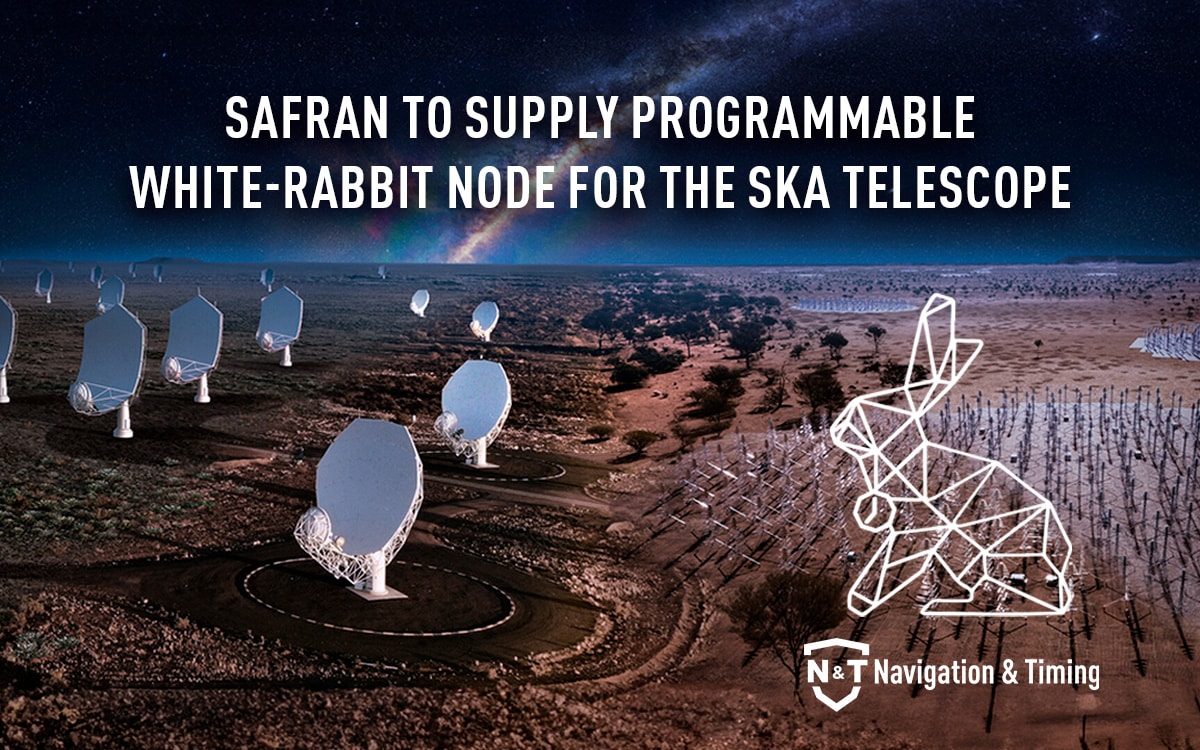
# News
Safran to Supply Programmable White-Rabbit Node for the SKA Telescope
Safran to supply UTC dissemination based on White-Rabbit nodes providing high accuracy timing for the SKA telescopes, the largest and most capable distributed radio telescopes of their kind.
A milestone in radio astronomy technology, the SKA Telescope PPS Distribution System will synchronize through White Rabbit thousands of antennas and dishes spread across Australia and South Africa.
GRANADA, SPAIN – June 29, 2023 – Safran Electronics & Defense will provide more than 200 White Rabbit (WR) devices for the Square Kilometer Array Observatory (SKAO). The SKAO is building two next-generation radio telescopes that will revolutionize our understanding of the universe by observing the sky in unprecedented detail.
“The integration of White Rabbit technology with the SKA telescopes represents a crucial step in ensuring the success of this pioneering project,” said Carlos Valenzuela, Navigation & Timing, Product Manager with Safran Electronic & Defense. “White Rabbit allows users to synchronize remote devices within one billionth of a second (1 nanosecond). It will enable the telescopes to achieve the level of precision and accuracy required to generate groundbreaking scientific insights into the mysteries of the universe.”
The SKA telescopes will allow astronomers to observe the universe over a broad range of frequencies, from low-frequency radio waves at 50 MHz up to mid-frequency waves of 15.4 GHz. The data generated by the SKA telescopes will be used to study a wide range of astrophysical phenomena, from the formation of the first stars and galaxies to dark matter and signatures of life beyond Earth.
Australia will host the SKA-Low telescope, which will have 131,072 antennas receiving low-frequency radio waves. Each antenna will be 2 meters tall and shaped like a Christmas tree. South Africa will host the SKA-Mid telescope, comprised of 197 dish antennas receiving mid-frequency radio waves.
“The SKA telescopes encompass an advanced Distributed Data Acquisition (DAQ) system, which converts different analog environment signals into digital values to perform control and monitor tasks,” Valenzuela added. “The SKA project has a strict timing requirement for its operation with a performance below two nanoseconds, which is not achievable by Network Time Protocol (NTP) or Precise Time Protocol (PTP) technology. The WR-Z platform is a critical solution developed through Safran’s Navigation & Timing portfolio for the SKA telescopes’ pulse per second (PPS) distribution system. It is a new design integrating WR technology, thus enabling subnanosecond accuracy.”
Carlos Frias, EMEA Technical Sales Market Manager for Safran Trusted 4D, said the WR-Z had been evaluated in different scenarios to demonstrate its timing performance in dynamic environment conditions fulfilling the SKA telescopes’ requirements for PPS distribution. He added that the White Rabbit technology, a component of Safran’s Navigation and Timing solutions, was developed at the Safran site in Granada, Spain. It is noteworthy that Spain, being a member country of SKAO, was awarded the contract for the White Rabbit project as part of their collaborative efforts.
To learn more about Safran’s Navigation & Timing solutions please visit: www.safran-navigiation-timing.com.
About the Square Kilometer Array Observatory (SKAO)
The Square Kilometer Array Observatory (SKAO) is a state-of-the-art astronomy-driven big data facility with a mission to build and operate cutting-edge radio telescopes to transform our understanding of the universe and deliver benefits to society through global collaboration and innovation. Once in operation, the SKAO will be one international observatory operating two telescopes across three continents on behalf of its member states and partners. Spain is the latest country to have completed its accession to the observatory, with Spanish participation led by the Instituto de Astrofísica de Andalucía (IAA-CSIC) in Granada. You can learn more about the history of the project on the SKAO website.


